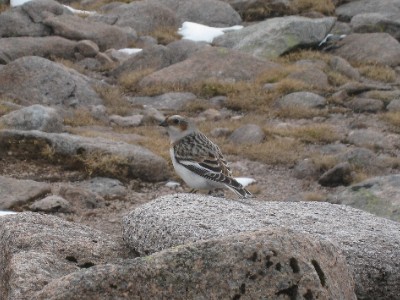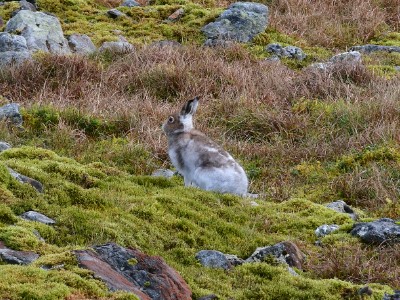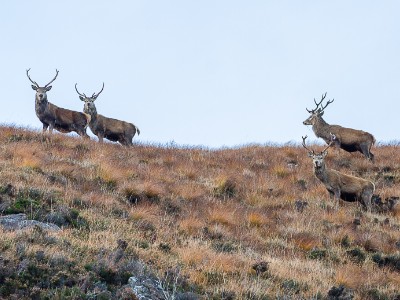Thursday 13th October 2022, 3:13pm
What to look out for in the hills this season
#AutumnAdventures

With Mountaineering Scotland's Access & Conservation Officer Davie Black
You may think that after the glorious purple haze of heather
bloom has gone, and you have sampled the last of the Blaeberries, nature
has closed up until spring, but from late September through until December, the
autumn season can still offer delights for anyone interested in the wildlife of
the mountains.
Much of the birdlife of the uplands will have moved away, either migrating to warmer lands in the south or to the more temperate conditions in the lowlands or around the coast, where intertidal mudflats offer abundant food. However, a year-round resident in the mountains is the Ptarmigan, which may be easier to spot at this time of year as its plumage moults from a cryptic summer camouflage against rock and heather, to the white of lying snow.
An autumn visitor who stays over the winter is the Snow Bunting, migrating from its summer breeding grounds in the high arctic to the relatively benign climate of the Scottish mountains in winter. There are a few who stay the spring and summer and breed high in the corries and cliffs, but their numbers are increased in autumn as they flock together and scour the vegetation for seeds and insects.
Image: Snow Bunting on Ben McDui (Credit: Neil Reid)

Another animal that changes colour to match the season is the Mountain Hare. If you see a hare above 400m it is likely to be the mountain hare, its bluish-grey fur in spring and summer changing to white to blend into snow-cover. It has been difficult for ecologists to get an accurate number of hares in Scotland.
Now walkers and climbers can send in their sightings to get a better picture of where mountain hares are and how many of them there are. Details of how to get involved can be found here.
Image: Mountain Hare on Ben Chonzie (Credit: Fiona McNicol)
This is also the red deer breeding season, known as the rut. Stags become very territorial, rounding up groups of hinds and their calves, and challenging other stags in their territory. You may hear them barking and roaring to deter challengers to their harem, which can end up with the clashing of antlers. A great sight to see and hear, but with these large animals charged with testosterone, it is advisable to keep a good distance away from them.

Deer are still stalked and shot in the autumn as the stag season ends mid-October, with the hind cull starting and continuing until mid-February. Land managers will be shooting hinds to keep the deer population under control to reduce environmental damage, so be aware that stalking may be taking place.
Heading for the Scottish Hills gives information for those taking in Munros on what the estate may be doing, with contact details. This is a voluntary information service and not all landowners participate in it.
Image: Red stags (Credit: Annie MacDonald)
As the leaves of deciduous trees change colour into yellow and russet autumn colours, the lone outliers high in the hills become more obvious against the drab background vegetation. Reforesting Scotland think that Birch trees surviving above 600m altitude may be a special variant of the Downy Birch of the lower slopes. They are looking for records of these hardy specimens – you can help by looking out for birch trees above the nominal ‘tree line’ of 600m and entering records on Reforesting Scotland’s dedicated web page.
Going even higher up the hill, the Montane Woodland Action Group are keen to find out about the ‘wee trees’ living above 900m altitude – Rowan, Dwarf Birch, and a variety of small, ground-hugging willows.

The highest ever tree record is 1160m for a Scots Pine on Cairn Lochan, near Cairngorm; highest Rowan in Britain at 1150m on Sgùrr nan Ceathreamhnan, Glen Affric; highest Birch 1026m recorded on Ben Nevis.
You can use #HighMountainTrees on Twitter to post finds of trees growing over 900m, or join the Facebook group High-altitude trees of Britain and Ireland.
You can get involved by adding records and queries on the Montane Woodland Action Group website where an official records form is coming soon.
Autumn in the mountains is therefore a time of change, and transition, with plenty to see and hear on your way through the hills. So, whether it is an abundance of fungi in the heather and grass, the fleeting glimpses of birds and mammals, or the textures and patterns of the ever-present lichens and mosses on stone, nature adds life to the rocks.
Image: The highest Rowan in Britain (1150m) on Sgùrr nan Ceathramhnan (Credit: Sarah H. Watts)
Don't forget to tag us using #AutumnAdventures when you're out and about in the hills this season